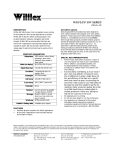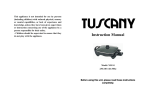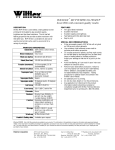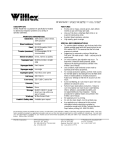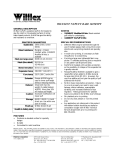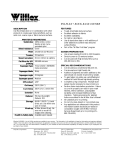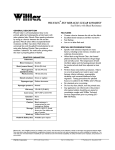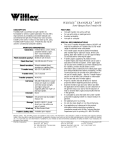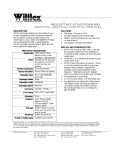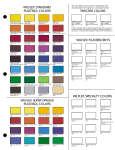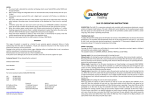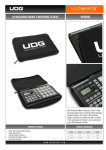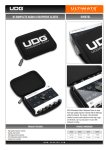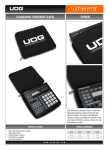Download wilflex ® athletic trophy white #11003wht
Transcript
WILFLEX ® ATHLETIC TROPHY WHITE #11003WHT GENERAL DESCRIPTION Wilflex Athletic Trophy White is a high viscosity plastisol screen printing ink formulated to give ultimate opacity and bleed resistance along with excellent mat-down characteristics. Though designed for direct printing on fabrics subject to dye bleeding and/or sublimation, Athletic Trophy White is a premium ink useful to those printers who wish to use one ink for most jobs. RECOMMENDED SUBSTRATES Wilflex Athletic Trophy White may be printed on cotton, cotton blends, polyesters, some nylons (generally open weave or mesh types) and other synthetics. On some types of fabric, dye migration may occur. To determine a material's bleed potential, please refer to the testing procedures outlined in the "Evaluating Plastisol Inks" section of the Wilflex User's Manual. Preprint and test all fabrics for dye bleeding, ink adhesion, wash fastness and other desired properties. PRINTING RECOMMENDATIONS Mesh: For optimum opacity, a 60-120 threads/in (24-49 threads/cm) mesh is recommended. For light color and medium fabrics or fine line printing, a 120-200 threads/in (49-77 threads/cm) mesh gives good results. Some modifications may be required when using finer meshes. Squeegee: Medium durometer, slightly rounded blade. Emulsion: The product contains no solvent or water. Screens may be prepared with conventional direct emulsions or capillary films. • • Automatic Prints - Athletic Trophy requires a hard flood and a medium stroke. A 75 or a 60/90/60 durometer squeegee at a 35-degree angle is recommended. Manual Printing - Opacity is optimized with a hard flood, and a hard, slightly slower stroke with a 45 degree angle using a 75 durometer square squeegee. Using a softer squeegee may require a slower stroke by the operator. When printing is finished, remove ink from the screen. CURING Gel or Flash cure: 170-189 F (76-87 C). Due to differences in power, height above ink film, and efficiency of the flash unit, a specific dwell time cannot be given. Incorporating the use of finer mesh counts for your flash plate will decrease the dwell time needed to gel the ink, resulting in faster production speeds. Be certain to set flash dwell times on heated pallets to simulate production. Adjust your settings so that the ink is just dry to the touch. Avoid excessive overflashing, as it can result in poor inter-coat adhesion of overprint colors. Cure: 320 F (160 C) throughout the entire ink film. Fusion tests should be performed prior to production printing. Failure to cure ink properly can result in poor wash fastness, inferior adhesion, unacceptable durability and increased likelihood of dye migration. Maximum ink tensile strength and elongation is accomplished by ensuring total fusion of the ink film. Testing procedures for plastisol fusion are outlined in the Wilflex Textile User's Manual. MODIFIERS Wilflex Athletic Trophy White can be used straight from the bucket. Some stirring will help break down the false "body" that occurs in plastisol inks over time. Athletic Trophy White may be modified with Miracle Clear #10160 or a small amount of Curable Reducer #10070 (1-5 percent by weight) to lower viscosity. Please note: Excessive modification will reduce the bleed resistance of Athletic Trophy White and may cause problems in curing or flash curing. WASH-UP Conventional solvents or Wilflex Screen Wash. HEALTH AND SAFETY Complete Health and Safety Data available upon request. STORAGE Recommended storage temperature is 65-90 F (18-32 C). Avoid storing in direct sunlight or in extreme temperature conditions. It is recommended that Wilflex products be used within one year of receipt of product. Inks subjected to extreme temperatures or prolonged shelf life could thicken or expand in the container. As with any plastisol ink, store ink in container with lid closed. Effective 02/22/2001. Not all Wilflex products are available in every country. The information in this publication is based on information and experience believed reliable. Since many factors may affect processing for an application, processors must carry out their own tests and experiments to confirm suitability for intended use. You must make your own determination of suitability for your intended use and environmental acceptability, the safety and health of your employees, and purchasers of your product. PolyOne Corporation 8155 Cobb Center Drive Kennesaw, GA 30152 Tel: 800-326-0226; 770-590-3500 Fax: 678-290-2749 Unit 12, Orbital One Green St. Green Rd. Dartford, Kent DA1 1QG UK Tel: (+44) 01322 277778 77 Parkhurst Dr, Knoxfield 3180 Victoria, Australia Tel: (+61) 3 9887 1522


